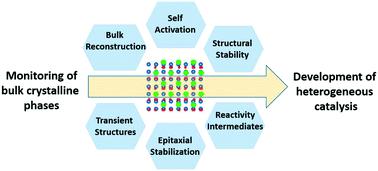当前位置:
X-MOL 学术
›
CrystEngComm
›
论文详情
Our official English website, www.x-mol.net, welcomes your
feedback! (Note: you will need to create a separate account there.)
How the in situ monitoring of bulk crystalline phases during catalyst activation results in a better understanding of heterogeneous catalysis
CrystEngComm ( IF 2.6 ) Pub Date : 2021-09-01 , DOI: 10.1039/d1ce00817j Simon Penner 1
CrystEngComm ( IF 2.6 ) Pub Date : 2021-09-01 , DOI: 10.1039/d1ce00817j Simon Penner 1
Affiliation

|
The present Highlight article shows the importance of the in situ monitoring of bulk crystalline compounds for a more thorough understanding of heterogeneous catalysts at the intersection of catalysis, materials science, crystallography and inorganic chemistry. Although catalytic action is widely regarded as a purely surface-bound phenomenon, there is increasing evidence that bulk processes can detrimentally or beneficially influence the catalytic properties of various material classes. Such bulk processes include polymorphic transformations, formation of oxygen-deficient structures, transient phases and the formation of a metal–oxide composite. The monitoring of these processes and the subsequent establishment of structure–property relationships are most effective if carried out in situ under real operation conditions. By focusing on synchrotron-based in situ X-ray diffraction as the perfect tool to follow the evolution of crystalline species, we exemplify the strength of the concept with five examples from various areas of catalytic research. As catalyst activation studies are increasingly becoming a hot topic in heterogeneous catalysis, the (self-)activation of oxide- and intermetallic compound-based materials during methanol steam and methane dry reforming is highlighted. The perovskite LaNiO3 is selected as an example to show the complex structural dynamics before and during methane dry reforming, which is only revealed upon monitoring all intermediate crystalline species in the transformation from LaNiO3 into Ni/La2O3/La2O2CO3. ZrO2-based materials form the second group, indicating the in situ decomposition of the intermetallic compound Cu51Zr14 into an epitaxially stabilized Cu/tetragonal ZrO2 composite during methanol steam reforming, the stability of a ZrO0.31C0.69 oxycarbide and the gas-phase dependence of the tetragonal-to-monoclinic ZrO2 polymorphic transformation. The latter is the key parameter to the catalytic understanding of ZrO2 and is only appreciated in full detail once it is possible to follow the individual steps of the transformation between the crystalline polymorphic structures. A selected example is devoted to how the monitoring of crystalline reactive carbon during methane dry reforming operation aids in the mechanistic understanding of a Ni/MnO catalyst. The most important aspect is the strict use of in situ monitoring of the structural changes occurring during (self-)activation to establish meaningful structure–property relationships allowing conclusions beyond isolated surface chemical aspects.
中文翻译:

催化剂活化过程中体相结晶相的原位监测如何更好地理解多相催化
本亮点文章展示了原位监测块状晶体化合物对于更深入地了解催化、材料科学、晶体学和无机化学交叉领域的多相催化剂的重要性。尽管催化作用被广泛认为是一种纯粹的表面结合现象,但越来越多的证据表明,本体过程会对各种材料类别的催化性能产生不利或有利的影响。这种本体过程包括多晶型转变、缺氧结构的形成、瞬态相和金属氧化物复合材料的形成。如果在实际操作条件下现场进行,对这些过程的监控以及随后建立的结构-性能关系是最有效的。通过关注基于同步加速器的原位X 射线衍射作为追踪晶体物种演化的完美工具,我们通过来自催化研究各个领域的五个例子来例证这一概念的优势。随着催化剂活化研究日益成为多相催化领域的热门话题,甲醇蒸汽和甲烷干重整过程中基于氧化物和金属间化合物的材料的(自)活化受到关注。选择钙钛矿LaNiO 3作为例子来展示甲烷干重整之前和过程中的复杂结构动力学,只有在监测LaNiO 3转化为Ni/La 2 O 3 /La 2 O 2过程中的所有中间晶体物种时才能揭示这一点。二氧化碳3。ZrO 2基材料形成第二组,表明金属间化合物Cu 51 Zr 14在甲醇蒸汽重整过程中原位分解成外延稳定的Cu/四方ZrO 2复合材料,ZrO 0.31 C 0.69碳氧化物和气体的稳定性-四方到单斜ZrO 2多晶型转变的相依赖性。后者是理解ZrO 2催化的关键参数,并且只有在能够跟踪晶体多晶型结构之间转变的各个步骤时才能全面详细地理解。选定的示例专门介绍了甲烷干重整操作过程中结晶活性碳的监测如何帮助理解 Ni/MnO 催化剂的机理。最重要的一点是严格使用原位监测(自)激活过程中发生的结构变化,以建立有意义的结构-性质关系,从而得出超越孤立表面化学方面的结论。
更新日期:2021-09-01
中文翻译:

催化剂活化过程中体相结晶相的原位监测如何更好地理解多相催化
本亮点文章展示了原位监测块状晶体化合物对于更深入地了解催化、材料科学、晶体学和无机化学交叉领域的多相催化剂的重要性。尽管催化作用被广泛认为是一种纯粹的表面结合现象,但越来越多的证据表明,本体过程会对各种材料类别的催化性能产生不利或有利的影响。这种本体过程包括多晶型转变、缺氧结构的形成、瞬态相和金属氧化物复合材料的形成。如果在实际操作条件下现场进行,对这些过程的监控以及随后建立的结构-性能关系是最有效的。通过关注基于同步加速器的原位X 射线衍射作为追踪晶体物种演化的完美工具,我们通过来自催化研究各个领域的五个例子来例证这一概念的优势。随着催化剂活化研究日益成为多相催化领域的热门话题,甲醇蒸汽和甲烷干重整过程中基于氧化物和金属间化合物的材料的(自)活化受到关注。选择钙钛矿LaNiO 3作为例子来展示甲烷干重整之前和过程中的复杂结构动力学,只有在监测LaNiO 3转化为Ni/La 2 O 3 /La 2 O 2过程中的所有中间晶体物种时才能揭示这一点。二氧化碳3。ZrO 2基材料形成第二组,表明金属间化合物Cu 51 Zr 14在甲醇蒸汽重整过程中原位分解成外延稳定的Cu/四方ZrO 2复合材料,ZrO 0.31 C 0.69碳氧化物和气体的稳定性-四方到单斜ZrO 2多晶型转变的相依赖性。后者是理解ZrO 2催化的关键参数,并且只有在能够跟踪晶体多晶型结构之间转变的各个步骤时才能全面详细地理解。选定的示例专门介绍了甲烷干重整操作过程中结晶活性碳的监测如何帮助理解 Ni/MnO 催化剂的机理。最重要的一点是严格使用原位监测(自)激活过程中发生的结构变化,以建立有意义的结构-性质关系,从而得出超越孤立表面化学方面的结论。











































 京公网安备 11010802027423号
京公网安备 11010802027423号